Roundtable Discussion What We Want to Teach and Learn at CMSI
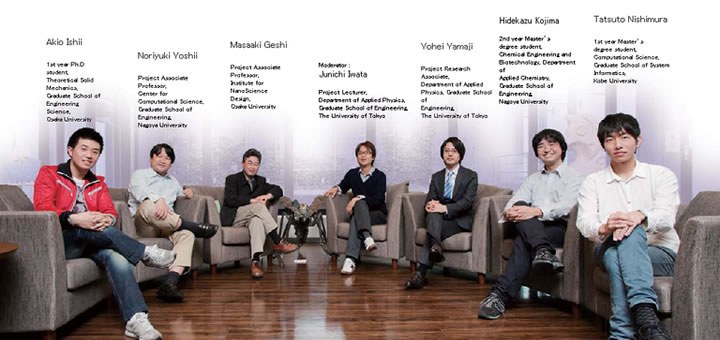
Starting with graduate school courses
Iwata (Moderator) : I don’t have the experience to talk about CMSI education overall, but I’d like to begin from the explanation of a basic premise of today’s discussion. It’s clear that computers become increasingly complex and it’s becoming difficult to write extensive program codes on the side of our primary work. So, we have to consider how to hone our skill at using such advanced computers while pursuing our researchs and how to make it easy for students to enter the field of computational materials science. Instructors, what are you planning to do at CMSI from the next fiscal year?
Yoshii : Right now I’m in the process of formulating teaching plans. There are existing frameworks that can be adapted for CMSI projects with slight modification, and I’ ll utilize those. For example, this fiscal year we started supporting the Molecular Simula tion School that had previously been held by the Molecular Simulation Society of Japan. In December, we will hold a Molecular Simulation School that will be organized by CMSI and the Institute for Molecular Science. In the next fiscal year, we plan to create a credit transfer system using the existing systems between Nagoya University and the Graduate University for Advanced Studies. This will enable students to attend lectures on molecular simulation in the Advanced Molecular Physical Chemistry Course at Nagoya University and lectures on computational science at the Graduate University for Advanced Studies.
Iwata : Are you teaching at the Molecular Simulation School ?
Yoshii : Yes, I teach a class on parallelization. I start from the very basics, such as the structure of parallel computers, and cover up to OpenMP. I cram all of that into an hour and a half. Each time, there are about 100 students. I’m happy to see that molecular simulation has gotten this much exposure.
Kojima : I’ve attended the school twice, and I know a lot of people who have attended it.
Geshi : At Osaka University, there are Computational Materials Design (CMD®) workshops twice a year in which the density functional theory is mainly focused. The next one will be the 20th to be held. It’s a five-day training camp style workshop. Students who attend can get graduate school credit at Osaka University, and it’s also a required course for the continuing education program. But members of the general public who have no connection to any of those attend the workshop as well. There are four courses: a beginner’s course, an advanced course that expands on the beginner’s course, an expert course, and in 2010 a supercomputer course was also added. In the supercomputer course, a small group of students learn how to master supercomputers and the ways in which they can be used. Up to now, the course has been held using up to 8 nodes of the SX-9 in the Osaka University Cybermedia Center.
This workshop is popular with students who want to learn first principle calculations. Even if you’ re from the experimentation side and you feel self-conscious about knocking on the door of a research institute and asking to learn from them, you can feel free to ask any question you like.
Iwata : And you can get college credit by attending the workshop?
Geshi : Yes. The credits are approved as long as you receive the certificate of completion. Also, to make it easy for people who have jobs, the courses are broadcast nationwide from 6:00 to 9:00 in the evening over a teleconferencing system. So you can study all the way through from basics to application.
Yamaji : The goal of CMSI instruction overall is to coordinate with all the other Educational Divisions. However, at the University of Tokyo there is not yet an adequate framework for delivering courses. For this reason, at the outset, we plan to begin in FY 2012 with 1st and 2nd year Master’s degree courses taught on-campus together with Prof. Iwata. The courses will deal with linear algebra, the Monte Carlo method, partial differential equations and other mathematical topics relating to time evolution. In addition, students will write their own programs from scratch, starting from the simple things, and have students train up through parallelization using MPI and OpenMP. We’ll prepare a PC cluster environment that allows students to freely use up to 120 processors in parallel.
Yoshii : How many students do you anticipate being in each class?
Iwata : We’ve reserved a study room that can accommodate 80 students. But we only
expect about a half of the number.
Yamaji : Ultimately, we’re planning to receive courses from the other CMSI Educational Divisions and transmit our courses to the others. At present, there is no credit transfer system between the Divisons, so we plan to start with places nearby like Tokyo Institute of Technology and Ochanomizu University and accumulate experience, as well as cooperating with Prof. Geshi and Prof. Yoshii to deliver courses.
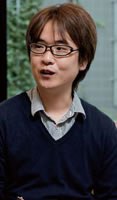 | 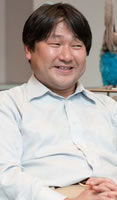 | 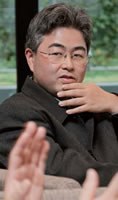 |  |
|---|---|---|---|
| Junichi Iwata Specializes in the first principle calculations and density functional calculations in the condensed matter physics. Currently using massively parallel computers to develop code for large-scale first-principles calculations. |
Noriyuki Yoshii Uses molecular dynamics calculations to study the interaction between biomembranes and drugs, as well as drug membrane permeation phenomena. |
Masaaki Geshi Specializes in first-principles calculations and density functional theory (DFT) calculations. Designs new materials that are synthesized at high temperature and high pressure. In terms of large-scale computing, parallelizes the Order N tight-binding approach using MPI and conducts experiments using approximately 2 million atoms. |
Yohei Yamaji Earned his degree through analytical research of copper-oxide superconductors and other strongly-correlated electron systems. Currently conducts numerical calculations for many-body electron systems. Expected to be involved in code development for parallel computing with 10,000 ‒ 100,000 processors in the future. |
Interchange with computer science is also education
Iwata : As students, what kinds of things are you hoping for the courses?
Ishii : We have to study a lot if we want to be able to do parallel computing well enough to enable our knowledge to stand up to actual use in research. We all want to use parallel computing for practical research, but how should we approach that?
Yoshii : There are two sides in CMSI. One is the people who develop the codes for the K Computer, the fastest computer in the world. The other is the people who want to use the K Computer to do actual research. I think we have to teach the users and the codewriters differently.
Yamaji : The issue is practical application. Even when you talk about parallel computing,
if you’re using the Monte Carlo method, for up to 100 parallel computers or so you don’t need any specialist study.
Yoshii : If there’s existing code, then you can use that. But particularly in the case of molecular dynamics (MD), you can’t clearly sort things into “OK, for this calculation we can use such-and-such a routine.” If you don’t have any code, you have to begin your research by writing the code.
Iwata : There are many program libraries in which the most commonly used calculations are collected. One way would be to have your own programs linked to those libraries.
Yoshii : It’s definitely true that some parts of the programs we’ve written are ridiculously slow. If one replaces those sections by a numerical librariy, sometimes performance suddenly picks up.
Geshi : It’s difficult to sit down and really focus on numerical techniques, but there are certain things that you should know. What about the idea of getting information from specialists in numerics? It seems like CMSI should take the lead in that kind of interchange.
Iwata : On the theory that interchange will turn into education.
Geshi : There’s an advantage in using the code for people like us, but conducting joint research with us also provides advantages to the people who create the code. I think we need a place where research “needs” could be matched with research “seeds” and the joint researches could be expanded into the development of new algorithms and so on.
Kojima : I’m interested in writing programs and gaining an understanding of the principles. If possible, I’d like to write programs myself. Right now I’ m working on onedimensional reactions, but there’s room to expand this, to three dimensions and so on. If that happens, I guess I’ll have to write the program myself.
Yamaji : I hope students will be interested enough to do that.
Geshi : The Institute of Industrial Science at the University of Tokyo invites specialists from Hitachi to conduct intensive training courses in which students write programs in half a term.
Nishimura : Are the courses on parallelization designed for graduate students?
Yoshii : The credit exchange program is for graduate schools. But even at the undergraduate level, the physical chemistry laboratory instruction includes an introduction to molecular simulation.
Geshi : The current workshops are for graduate level and above, and even for working people they’re for people with a Master’s degree or above. The purpose is user training, so we have to encourage the use of simulations by showing how helpful they can be to undergraduates and members of the general public, and gather more people who want to do full-fledged omputational science.
Yamaji : I’m all in favor of providing instruction from the undergraduate level onward. But the fourth year students have to conduct experiments, and they have to study statistical mechanics and quantum mechanics as well. So the question is how to incorporate numerical calculations and how to motivate them.
Geshi : People from companies have clear motivation. There are even some who look to first-principles calculations to provide them with direction in their own research. And these days people in a management role can’t get by without a knowledge of first-principles calculations.
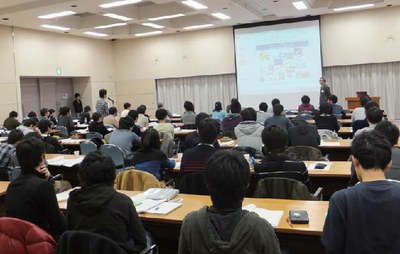
Many paths to large-scale computing
Iwata : I’d like to ask you, students. What type of research are you planning to do from now on?
Kojima : I want to go on to the next stage of higher education and continue doing research of proton transfer reactions in solutions. Right now I’m working on intramolecular reactions, but I’d like to expand this to reactions between molecules and threedimensional reactions. In intermolecular reactions, we have to deal with numerous molecules, so it gets even more difficult.
Iwata : You have not only the problem of the cost of computations, but also have the fact that the methodology has not yet been established. So you have to do everything: develop the theory, create the program and so on.
Yoshii : That’ s like what Mr. Ishii is working on, analysis of carbon diffusion in solids.
Ishii : The technique itself is in place, but there’s no immediate need for large-scale computing. My laboratory’s style is apparently to use small systems and keep the amount of calculations to a minimum to perform “smart” analysis of phenomena. We have a parallel computer of 20 processors with 8 cores each to perform parallel computing.
Iwata : Mr. Nishimura is developing programswith the prospect of parallel computing in mind.
Nishimura : In the PC cluster in our laboratory, I use only one core, and it’s now at the stage where we can use it for parallel computing from this point on. So at present we’re only using one node, but in the future I want to make them into programs designed for large-scale parallel computing that can run on the K Computer.
Iwata : In other words, your goal is not only parallelization using existing computing methods, you’re thinking about it from the algorithm level onward?
Nishimura : That’ s right. I only started learning parallelization after I joined the laboratory.
Iwata : Mr. Nishimura, since you have an information systems background, I’ d assumed you were using the parallel computers more than that.
Nishimura : We have a training course for third year students in which we connect four Macs together in parallel. So there are some undergraduate students who have a basic knowledge of parallelization. A computer science major was created a year ago, and I’ve just started studying parallel computing as well.
Yamaji : Are the fields of algorithms and code development highly regarded?
Nishimura : My laboratory focuses on chemistry, and it’s difficult for someone with an information systems background to come into the laboratory and suddenly be told to start doing chemistry. Leaving aside the question of whether or not you’ll receive recognition for it, it’s still computing. Computing doesn’t exist in a vacuum; it only has meaning once it’s linked to something else. So I think it’s important to carefully study fields of application.
Iwata : So you’re studying chemistry.
Nishimura : I’m taking a course in the theory of quantum mechanics, and I’m having a hard time. But I started on the path of computational science because I wanted to use supercomputers, so that’s fun. I’d love it if there were a type of hands-on training that used large-scale supercomputers.
Geshi : Do you want to use the K Computer?
Nishimura : You bet. I love the fact that computing speeds keep getting faster and faster.
Iwata : Mr. Kojima, you’ re going to be performing large-scale computing. Have you ever written programs?
Kojima : I’ve written simple MD programs in Fortran.
Yoshii : Have you had any instruction in parallelization?
Kojima : Not a bit. I studied using books in my laboratory.
Iwata : Mr. Ishii, you said you’re able to get along fine with the present scale of computing,
but do you write programs yourself?
Ishii : At our laboratory, we have a main MD program, and we modify that to match our
own research.
Yoshii : Regarding what you said about using statistical mechanics to accelerate
simulation, is that like the multicanonical method?
Ishii : Yes, it’s similar to that. My original motivation was that I wanted to analyze real-world phenomena, and it won’t be in proportion unless I’m able to increase the time scale. So I want to figure out some way of increasing the time scale.
Iwata : So rather than learning how to become a computer whiz, you want to improve the method. Where are the hurdles in terms of sampling?
Ishii : Sampling is similar to MD.
Geshi : If that’s the case, then if you run that program on a faster computer outside the
laboratory, it might be so fast that it would astonish you. I’m sure there will be barriers, but it’ s also important to see the outside world.
Yamaji : I know you students are all busy just trying to do the job that’s right in front of you, but you should at least preserve the feeling that it’s also good to see what’ s on the other side of the wall once in awhile. Pointing that out to students may also be part of our job.
 | 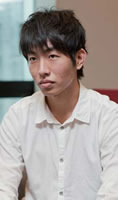 | 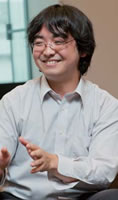 |
|---|---|---|
| Akio Ishii Affiliated with a condensed matter physics laboratory. Currently studying MD acceleration using a statistical-mechanical approach and its application to the analysis of solid interiors. |
Tatsuto Nishimura Studied information systems in his undergraduate days, but joined a quantum chemistry laboratory. Currently studying the development and implementation of algorithms for numerical calculation of two-electron integrals, as well as parallelization. |
Hidekazu Kojima Conducts MD simulations of intramolecular proton transfer reactions in solutions. As protons are light in weight, they must be treated as quantum particles, and methods for accomplishing this are currently under development. |
Courses you can access anytime, anywhere
Yoshii : Mr. Ishii, what was the educational system that enabled you to arrive at the main research topics in your laboratory? In the past, the attitude was that even if only those students who had managed to pull themselves up by their own bootstraps remained, that would be OK. But that’s too inefficient.
Ishii : We only discuss things when it’s necessary. The rest of the time, we pursue research on our own. The idea is that students should teach each other how to use the program.
Kojima : We get handed out research papers written by the research accosiate, and they give us a little instruction in how to use the program.
Geshi : At CMSI, we’ re in the process of putting together a curriculum. Assuming that students will write programs, would you like to hear more practical lectures, lectures on specific numerical algorithms, lectures on computer architecture and so on?
Ishii, Nishimura, Kojima : Yes !
Geshi : How about if we expanded the on-demand classes that you can access anywhere, and expand them to other fields besides chemistry?
Ishii : I’d also like to see the classes in video format that you could access anytime.
Geshi : The Osaka University program has video recordings, so you can hear the lecture either live or at a later time.
Yamaji : With that kind of system, it’s inconvenient if you can only view the videos if you’re registered. It would be best if they were offered free of charge, but I’m also concerned about the issue of copyright.
Geshi : At Osaka University, students who are registered for the class can access the content using their ID and password. Partly because of the copyright issue, the lectures are streaming only. Up to now, the classes have been presented once and then taken down. But that means the accumulated expertise is only available to your own students. I think at the very least it should be preserved for the community in Japan.
Iwata : Courses that you can access right away just be clicking on them are convenient,
but you can’t get college credit for them.
Ishii : That’ s OK ̶ provided that, in addition, you can ask questions easily and get a response.
Iwata : Maybe it would be good to make a CMSI version of “Tell Me Goo,” the Q&A function of the Japanese search engine, goo.
Geshi : It might be possible to get support from groups of Division Researchers and so on. But to get answers to questions, you’d need to come to class at least.
Iwata : We’ve heard a variety of opinions. It’s clear that the needs for utilization of advanced computers in researches will be greater and greater. We need to provide instruction in a way that doesn’ t require students to take much time away from their core tasks. We’d also like to propose dissemination systems to provide the courses on parallelization, tuning and programming tools to wider audiences not only within CMSI.
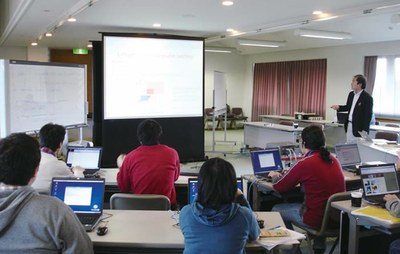
(Recorded December 8, 2011 at the CMSI Kobe Branch)
Photos:Shuich Yuri



